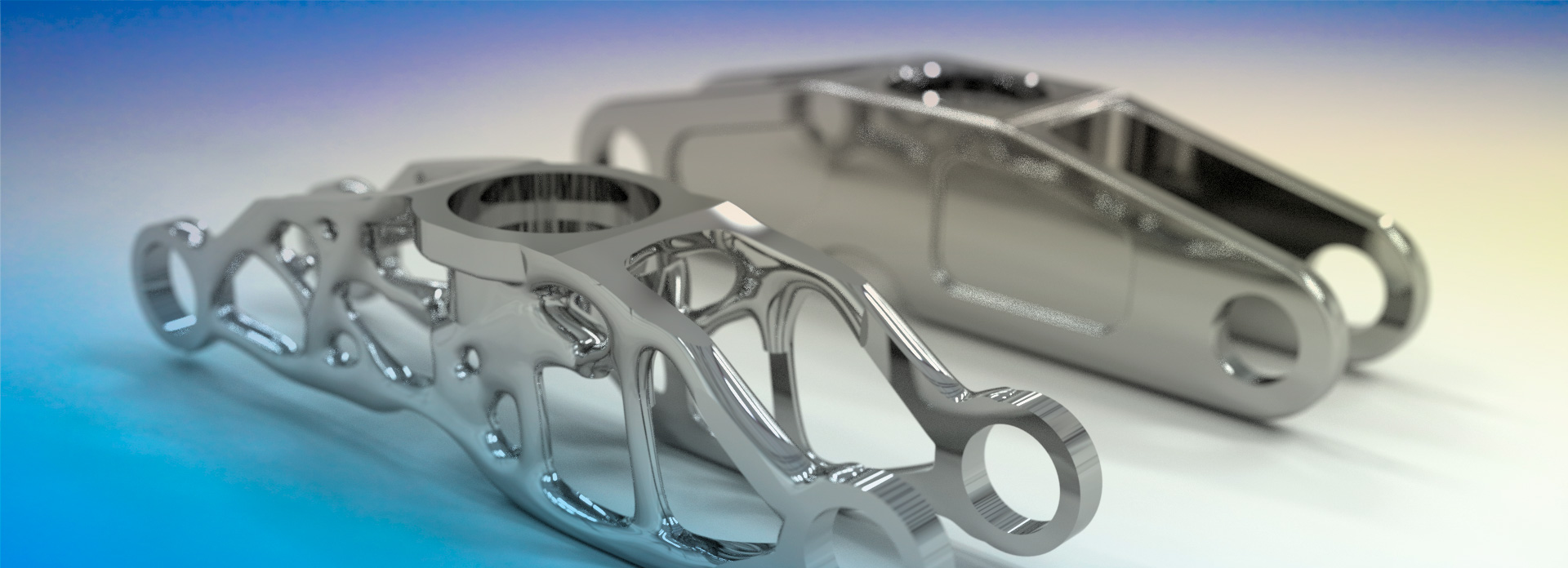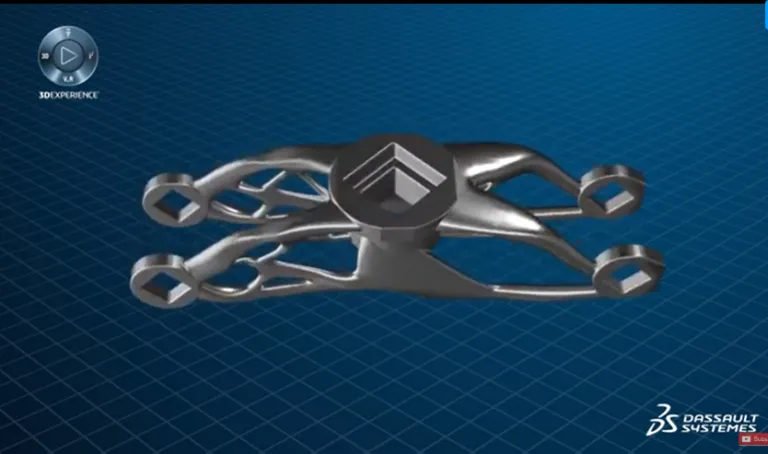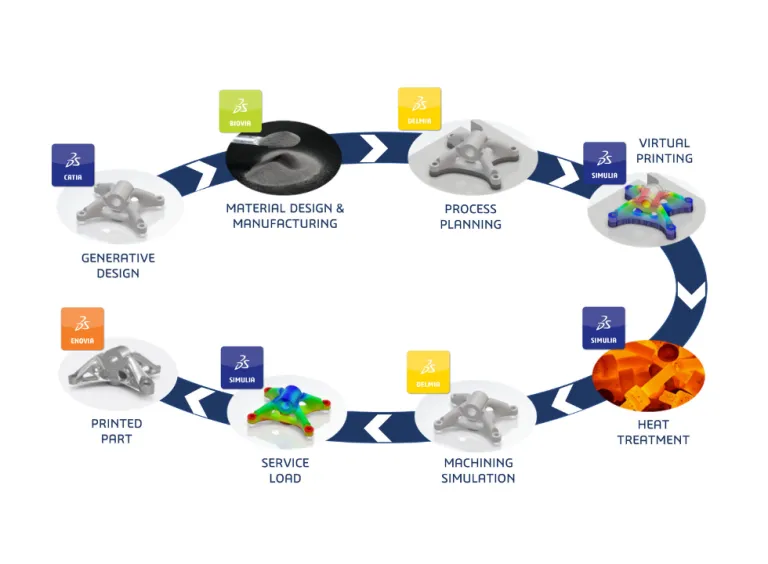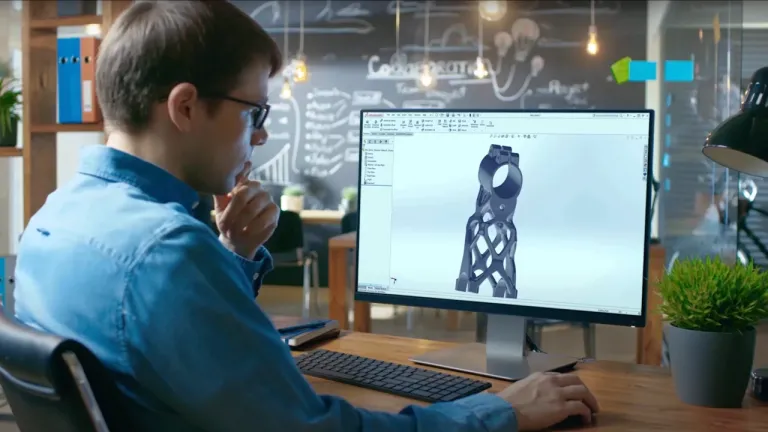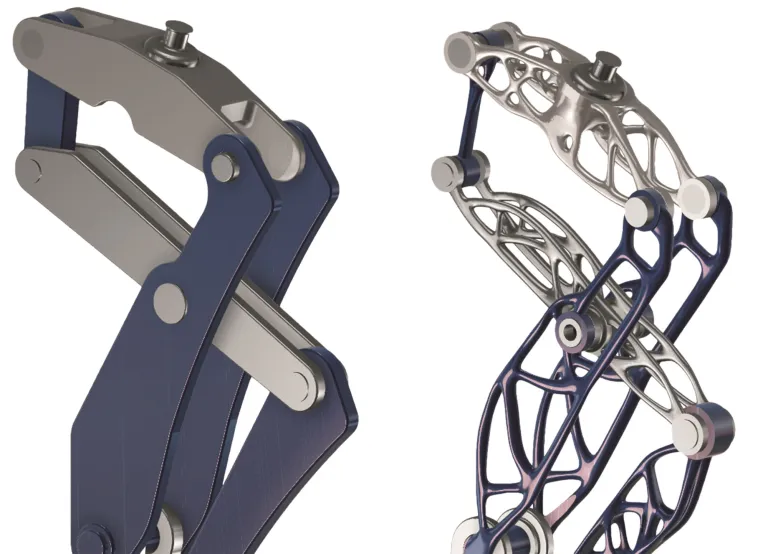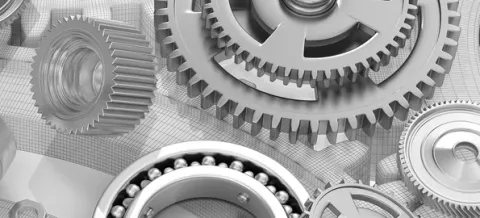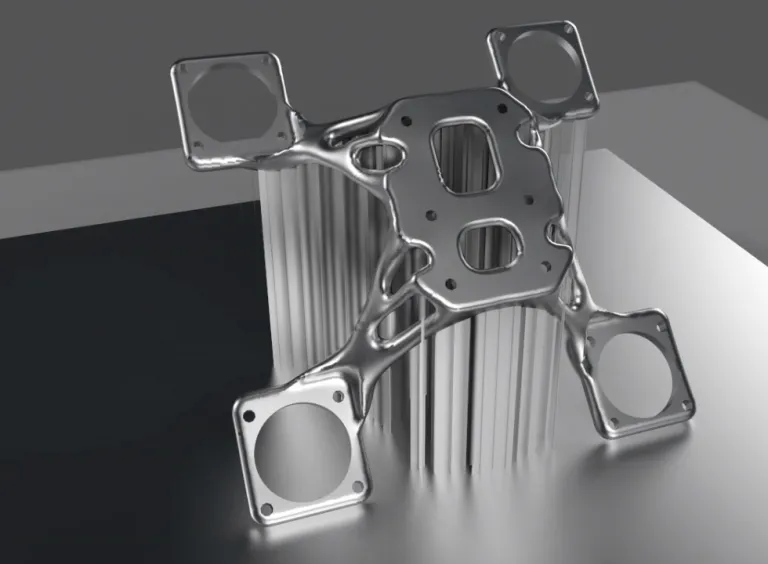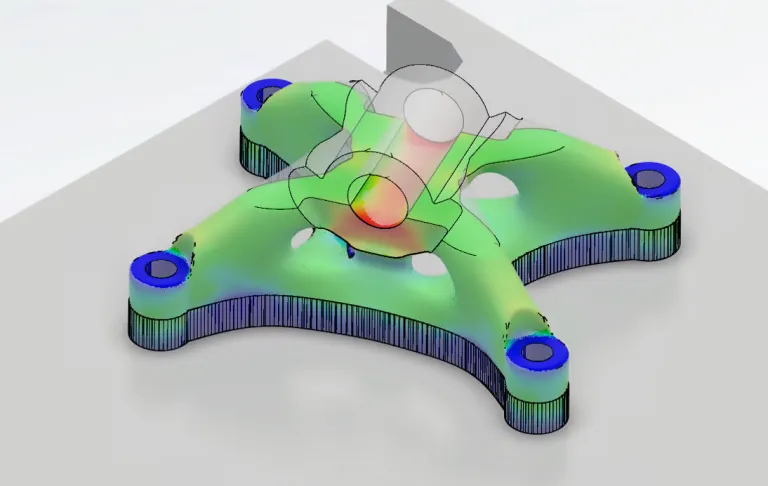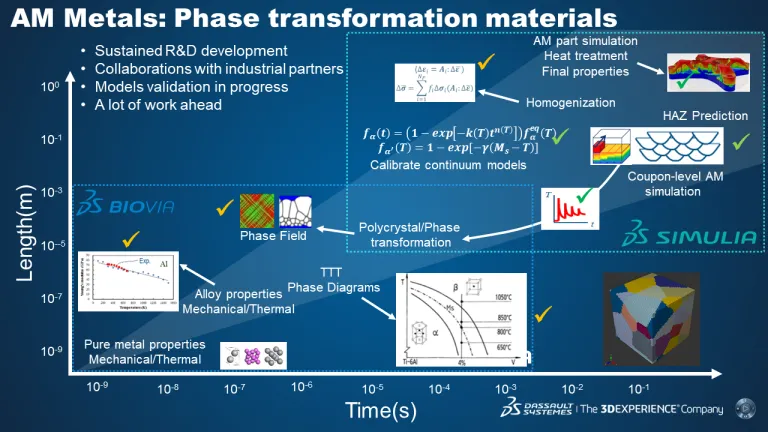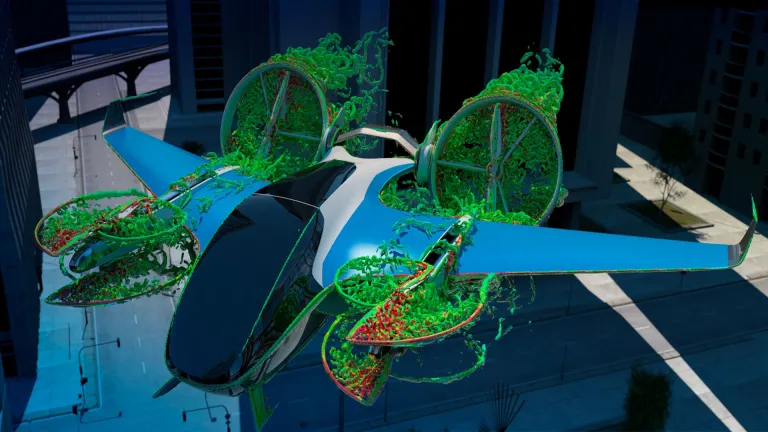Additive Manufacturing Simulation
Explore the Future of Fabrication with SIMULIA's Advanced Digital Additive Manufacturing Solutions
What is Digital Additive Manufacturing Simulation?
Digital Additive Manufacturing (DAM) is an advanced fabrication process in which parts or objects are built layer by layer through material addition. Traditional subtractive manufacturing methods, such as turning, drilling, and milling, remove material to achieve a desired shape. In contrast, additive techniques utilize 3D printing technology to develop components directly from digital models.
How does Digital Additive Manufacturing work?
In Digital Additive Manufacturing, a Digital Mock-Up (DMU) of the part or fabrication bed is created. This involves:
- Three-dimensional CAD representations: Geometric designs that depict the intended final product.
- Fabrication process representations: Detailed descriptions of methodologies, including material extrusion, recoating, scan paths, and energy deposition.
The entire process is managed digitally, and the resulting digital thread is converted into machine code, which gives specific commands for machines to follow during fabrication.
How does Simulation help in Digital Additive Manufacturing?
Additive Manufacturing (AM) presents unique challenges, but simulation transforms these obstacles into opportunities for innovation.
- Optimizing Design: AM's design freedom requires new paradigms. Simulation helps explore optimal forms while ensuring support structures are effectively integrated to prevent fabrication failures.
- Understanding Performance: Phase changes, driven by chemical reactions and thermal processes, significantly influence product performance. Simulation allows for predicting residual stresses and distortions that can arise during fabrication, enhancing overall reliability.
- Advanced Tools for Success: Simulation technologies, such as finite element analysis and computational fluid dynamics, enable virtual process testing and reverse product engineering. These tools provide valuable insights that refine design and production.
- Driving Efficiency: Using simulation capabilities, manufacturers can reduce development cycles, cut costs, and improve decision-making. The ability to anticipate and address potential issues before they arise mitigates program risks and ensures high-quality outcomes.
Key Benefits of Additive Manufacturing Simulation
Material Savings
Minimize waste and utilize advanced materials (e.g., TPU filaments, metal superalloys).
Design Flexibility
Use generative design techniques to create intricate geometries and lightweight structures.
Streamlined Processes
Consolidate multiple components into one part, cutting assembly time and costs.
Enhanced Sustainability
Promotes environmentally friendly manufacturing practices.
Elevate Collaboration with the 3DEXPERIENCE Platform
Digitalization minimizes time-to-market and costs by shifting design from linear to collaborative processes. Collaborative Engineering emphasizes efficient content sharing across the product lifecycle.
Design for Additive Manufacturing (DfAM) involves a multidisciplinary approach, utilizing generative design and topology optimization to reveal new opportunities. Virtual testing through simulations provides critical insights into build failure predictability and post-build product performance, which are closely tied to manufacturing processes and design specifications.
The 3DEXPERIENCE platform enables seamless data integration across disciplines, supports content lifecycle management, and cultivates a collaborative engineering environment. Effective content lifecycle management, maturity, and robust data organization enhance issue resolution, change management, routing, and testing, fostering a productive collaborative atmosphere.
Additive Manufacturing Digital Thread
Dassault Systèmes offers a portfolio of integrated applications to maximize the capabilities of additive manufacturing techniques by connecting all disciplines for an authentic end-to-end development chain from product design to manufacturing and simulation. The 3DEXPERIENCE platform provides numerous advanced roles and a rich set of powerful applications to cover all aspects of digital product development. The digital thread provided by the 3DEXPERIENCE platform ensures a tight connection between these powerful and intuitive applications, as highlighted in the tabs below.
- 3DEXPERIENCE Marketplace
- Function-Driven Generative Design
- Part Selection
3DEXPERIENCE Marketplace
3DEXPERIENCE Make is an on-demand manufacturing platform that connects designers and engineers with industrial manufacturing service providers. It connects the industrial ecosystem of Designers, Engineers, Buyers, and Production planners with industrial manufacturing service providers such as Xometry, Sculpteo, American Additive, Get It Made, Any-Shape, and more.
With our robust algorithm, you can get quotes in seconds from our network of service providers for your 3D printing and CNC machining project.
Function-Driven Generative Design
The emergence of additive manufacturing techniques enables the creation of efficient organic shapes and complex lattice structures that go beyond traditional engineering design. Unlike conventional methods that rely on best practices and an engineer's experience, Generative Design focuses on achieving optimal designs for specific functions based on defined constraints.
Additive manufacturing provides the flexibility to establish functional constraints that define design volumes, control mechanical interfaces, and target metrics like mass, stiffness, strength, and durability—all without restricting form. The Generative Approach within 3DEXPERIENCE integrates design, simulation, and optimization through guided workflows, delivering a streamlined solution for users within a single interface.
Part Selection
Powerful search tools in 3DEXPERIENCE can evaluate your part library and digital bill of materials to identify potential candidates for additive manufacturing.
Digital collaboration and intelligence on our platform ensure seamless real-time information sharing between all stakeholders so that product designers, engineers, and managers have a full view of the project at all times.
- Process Design & Production Planning
- Virtual Printing
- Materials Engineering and Development
Process Design & Production Planning
Fabrication applications on the 3DEXPERIENCE platform provide guided workflows to design and plan production and production processes associated with Additive solutions and machines. Commencing with creating or reusing build volumes and plates, automatically nest parts to maximize build volume usage, capture and reuse rules to assess optimal part orientation and compute minimal support structures. Specify custom rules for slicing, scan patterns and process parameters for the entire build or individual parts. Visualize the scan path for diagnostic checks and reuse process data in downstream Virtual Printing simulations and studies.
Virtual Printing
Use the 3DEXPERIENCE platform to lower time and material costs. Simulate part-build behavior and process sensitivities, including scan path and support structure performance. Accelerate simulations by integrating and reusing design data. Create user interfaces and workflows for manufacturing methods like Direct Energy Deposition, Select Laser Sintering, or Polymer Extrusion. Apply validated thermal-mechanical solutions to predict distortion and residual stress while identifying risks such as crack initiation and machine interference. Include assessments of fatigue life, account for post-build heat treatment, and ensure as-manufactured geometry matches as-designed geometry through digital compensation.
Materials Engineering and Development
Create virtual printers with multiple lasers or heat sources to control material deposition and removal while optimizing cooling methods for advanced manufacturing. Design metal alloys for additive manufacturing by analyzing micro-mechanics simulations to understand grain orientation and phase properties. With user-defined material models and comprehensive process parameters in our thermal-mechanical simulations, you can precisely engineer manufacturing processes and material properties for demanding AM applications. Coupled with powerful optimization tools in 3DEXPERIENCE, you have complete control over advanced AM process workflows.
Customer Testimonials
Listen to our customers in their own words. Check out these videos.
Start Your Journey
The world of Digital Additive Manufacturing is changing. Discover how to stay a step ahead with SIMULIA
Additive Manufacturing Resources
External Resources for Additive Manufacturing Simulation
FAQs about Additive Manufacturing Simulation
Also Discover
Learn What SIMULIA Can Do for You
Speak with a SIMULIA expert to learn how our solutions enable seamless collaboration and sustainable innovation at organizations of every size.
Get Started
Courses and classes are available for students, academia, professionals and companies. Find the right SIMULIA training for you.
Get Help
Find information on software & hardware certification, software downloads, user documentation, support contact and services offering
